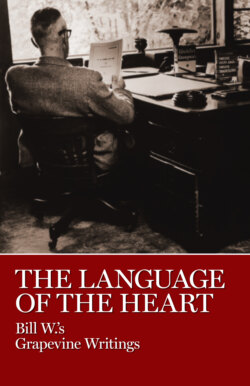Читать книгу The Language of the Heart - Bill W. - Страница 7
INTRODUCTION
ОглавлениеPublication of The Language of the Heart brings together for the first time virtually every article written for AA Grapevine by Bill W., co-founder of Alcoholics Anonymous. Though several of his articles are available in reprint form, whether as pamphlets, AA books, or in later issues of the magazine, they have never before been published in one volume.
In June 1944, Grapevine was established as a local newsletter through the individual efforts of six New York City AAs who were concerned about what seemed to be “a lack of understanding” among groups in the metropolitan area. Mailed by the six editors to all known groups in the U.S. and Canada, and sent free to AAs in the World War II armed forces, Grapevine soon caught on nationally. In 1945, by vote of the groups, it became the principal journal of the Fellowship as a whole, and since the January 1949 issue it has been known as the international journal of Alcoholics Anonymous.
From the first issue of the eight-page newsletter, Bill W. was a prolific contributor, an enthusiastic advocate, and for many years a consulting editor. In spite of a grueling travel schedule and a copious correspondence, Bill could never find enough time to respond to all the many and varied demands of a Fellowship that was still in the process of formation, and in Grapevine he discovered an ideal vehicle of communication with the members and groups who clamored for his insights and experience. In more than 150 articles, written over a span of twenty-six years, Bill documented the painstaking process of trial and error that resulted in AA’s spiritual principles of Recovery, Unity, and Service, and articulated his vision of what the Fellowship could become.
When the current Grapevine editors began to consider ways of grouping Bill’s articles in logical segments, it seemed at first a Herculean task—yet in the end it was not. Largely because of Bill’s own highly focused way of thinking and working, the articles virtually fell into place. They are arranged chronologically in three Parts, according to the primary AA concerns Bill was thinking and writing about during each period of time. They are further subdivided by major and minor subject matter within each Part. Brief introductions to Parts One, Two, and Three outline the major events and trends in AA that impelled Bill to emphasize a particular aspect of AA life, and in a few cases, an introductory sentence or two sets the context for a specific article. Toward the end appear a group of memorial articles (written in appreciation for several nonalcoholic friends of AA, as well as for Dr. Bob and for Bill D., AA Number Three), and an Appendix containing seven articles in which Bill reflected on the Grapevine itself.
While the intent is to make available the whole body of Bill’s Grapevine writings, a few omissions have been made because of length. His series of articles on the Traditions, written in 1952 and 1953 and later reprinted in the book Twelve Steps and Twelve Traditions, is readily accessible in that book and thus is not repeated here: similarly, two excerpts from AA Comes of Age that were reprinted as Grapevine articles have not been included, and one article that appeared twice in Grapevine appears only once here. All of Bill’s very brief (about half a page each) Christmas and Thanksgiving greetings to the Fellowship have been cut, with the exception of the December 1970 Christmas message, his last Grapevine piece. And finally, a few brief items (short memorial tributes to General Service Office staff and an announcement that the General Service Office was moving to a new location) have also been omitted.
Since this collection is by its nature an historical document, several characteristics should be mentioned. First, repetition: The articles appeared originally in a periodical publication, and Bill could never be sure that any reader had seen a previous one. Thus, he often repeated ideas or illustrations, and those repetitions have been retained to assure the integrity of Bill’s work. Second, some material has become outdated; for example, a few ideas that were articulated in very early articles about the Traditions proved unworkable in the light of later experience, but for the sake of historical accuracy, earlier versions have not been edited. And last, Bill was a man of his times, and some readers may find unfamiliar idioms and terminology, or may be taken aback by phraseology that would be considered inappropriate today. Once again, the original language (with a few changes that necessitated no rewriting) has been retained, because any tampering with phraseology might also have tampered with the meaning.
Bill W.’s most-quoted description of Grapevine appears in AA Comes of Age: “Grapevine is the mirror of AA thought and action, worldwide. It is a sort of magic carpet on which all of us can travel from one distant AA outpost to another, and it has become a wonderful exchange medium of our current thought and experience.” It is the hope of Grapevine editors that Bill W.’s timeless insights, written in the 1940s, ‘50s, and ‘60s, will serve as a mirror for AA members in the 1980s and beyond, reminding us of what it used to be like, documenting what happened and why it happened, and illuminating the present with the wisdom of AA’s experience in its first thirty years.
